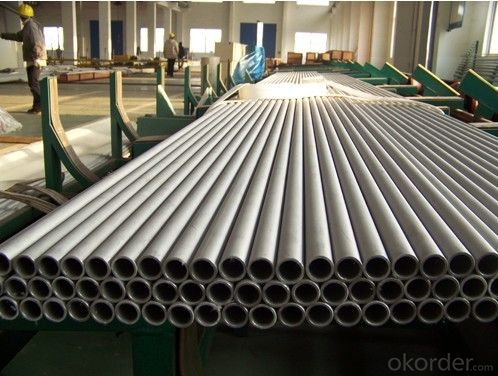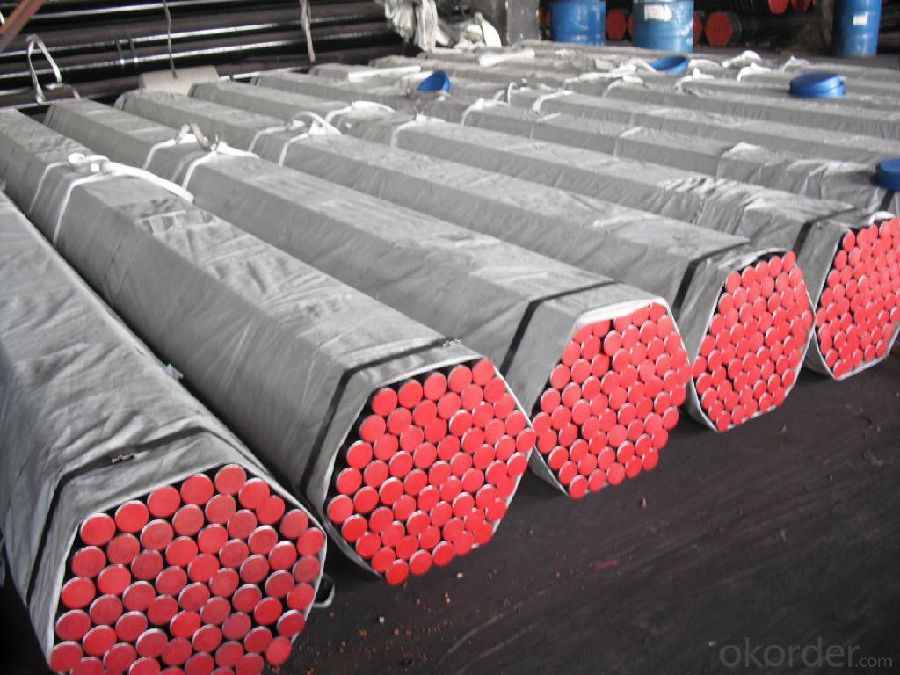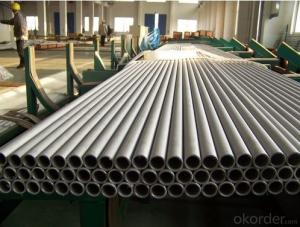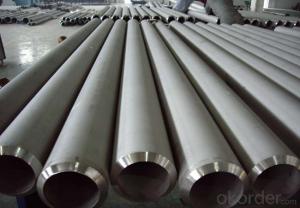Austenitic Seamless Steel Pipe Good Corrosion Resistance 304(0Cr18Ni9)
- Loading Port:
- Ningbo
- Payment Terms:
- TT OR LC
- Min Order Qty:
- 1 m.t.
- Supply Capability:
- 5000 m.t./month
OKorder Service Pledge
OKorder Financial Service
You Might Also Like
1、Structure of seamless steel pipe 304 Description:
A large amount of Seamless Steel Pipes 304 are offered to the clients at cost effective rates. These pipes are extremely durable, resistant to corrosion and have high tensile strength. Our pipes are used in nuclear plants, power plants, refineries and construction industry across the country. Furthermore, we are capable of providing these seamless pipes to the clients in bulk quantity.
2、Main Features of the seamless steel pipe 304:
• High manufacturing accuracy
• High strength
• Small inertia resistance
• Strong heat dissipation ability
• Good visual effect
•Reasonable price
3、seamless steel pipe 304 images:



4、seamless steel pipe 304 Specification:
1.Type:seamless
2.Standard:ASTM
3.Material Grand:304 stainless steel
4.Size:OD8-1000MM*WT0.5-80MM
Standard: | JIS, AISI, ASTM, GB, DIN, EN | Place of Origin: | Zhejiang China (Mainland) | Brand Name: | SR |
Type: | Seamless | Steel Grade: | 300 Series | Certification: | ISO |
Thickness: | 0.8mm--22mm | Outer Diameter: | 20mm--800mm | process: | Cold drawn,cold roll |
product: | seamless pipe/tube,elbow,tee,reducer | MOQ: | 1000kg | standard: | A312/A213/A269/A249/A358/A268/A789/ |
Packaging & Delivery
Packaging Detail: | Standard seaworthy package(wooden boxes package,pvc package, and other package) |
Delivery Detail: | 5-30 days after confirmation of prepayment depending on quantity |
Tolerance | a) Outer Diameter: +/- 0.2mm b) Thickness: +/- 0.02mm c) Length: +/- 5mm |
Surface | 180G, 320G, 400G Satin / Hairline 400G, 500G, 600G or 800G Mirror finish and so on. |
Specification | ASTM A213,ASTM A312,ASTM A269,ASTM A778,ASTM A790,DIN 17456,DIN 17458,JIS G3459,JIS G3463 etc |
Material | TP304,TP304L,TP304H,TP304/304L,TP316,TP316L,TP316/316L,TP310,TP317, TP317L,TP321,TP321H,TP347,TP347H,S31803,S32205(Duplex),904L etc |
Application range | Stainless steel pipe applies to construction field, ships building industry, petroleum & chemicalindustries, war and electricity industries,food processing and medical industry, boiler heat exchanger,machinery andhardware fields. Stainless steel pipe can be made accordingto the customers requirements. |
Delivery conditions | Annealed, pickled & polished. |
Note | We can produce other standard as the customers’ requirement. |
5、FAQ of seamless steel pipe 304:
①How is the quality of your products?
Our products are manufactured strictly according to national and internaional standard, and we take a test
on every pipe before delivered out. If you want see our quality certifications and all kinds of testing report, please just ask us for it.
Guaranteed: If products’ quality don’t accord to discription as we give or the promise before you place order, we promise 100% refund.
②How about price?
Yes, we are factory and be able to give you lowest price below market one, and we have a policy that “ for saving time and absolutely honest business attitude, we quote as lowest as possible for any customer, and discount can be given according to quantity”,if you like bargain and factory price is not low enough as you think, just don’t waste your time.Please trust the quotation we would give you, it is professional one.
③Why should you chose us?
Chose happens because of quality, then price, We can give you both.Additionally, we can also offer professional products inquiry, products knowledge train(for agents), smooth goods delivery, exellent customer solution proposals.Our service formula: good quality+good price+good service=customer’s trust
SGS test is available, customer inspection before shipping is welcome, third party inspection is no problem.
Any question, pls feel free to contact us !
- Q:Can stainless steel pipes be used in the food processing industry?
- The food processing industry can make use of stainless steel pipes. Stainless steel is a preferred option in food processing because it possesses numerous advantageous qualities. Firstly, stainless steel's resistance to corrosion is vital in an environment where food and liquids are constantly being handled and processed. Additionally, stainless steel's easy maintenance and cleaning are crucial for ensuring hygiene and preventing contamination in food processing. Stainless steel pipes are also highly durable and strong, enabling them to withstand the demanding conditions of the food processing industry. Furthermore, stainless steel does not react chemically with food or ingredients, ensuring that the quality and taste of processed products remain unaffected. Overall, stainless steel pipes are an exceptional choice for the food processing industry due to their resistance to corrosion, cleanliness, durability, and non-reactive properties.
- Q:Are stainless steel pipes resistant to scaling and pitting?
- Yes, stainless steel pipes are highly resistant to scaling and pitting due to their inherent corrosion-resistant properties.
- Q:Can stainless steel pipes be chromed?
- Indeed, it is possible to chrome stainless steel pipes. To achieve this, a layer of chromium is applied onto the surface of the stainless steel pipe through a process called chrome plating. Typically, this involves immersing the stainless steel pipe in a solution containing chromium salts, while an electric current is passed through the bath. As a result, the chromium adheres to the surface of the stainless steel pipe. This chrome plating not only enhances the appearance of the stainless steel pipe but also provides a protective finish, increasing its resistance to corrosion and wear.
- Q:Stainless steel and stainless steel pipe inside and outside polishing off, what is the difference?
- The inside and outside polishing tubes are polished by the surface of the polished material, and they look like bright ones, just like the mirror surface. Mainly used in viscous liquid and gas moving equipment, such as printing and dyeing, pulp and other industries
- Q:How do you prevent blockages in stainless steel pipes?
- To prevent blockages in stainless steel pipes, there are a variety of actions you can take: 1. Make sure to clean the pipes regularly in order to eliminate any buildup of debris or residue. This can be achieved by utilizing different cleaning techniques such as mechanical tools or chemical solutions that are safe for stainless steel. 2. Ensure proper disposal of waste materials by avoiding dumping substances like grease, oil, food scraps, or other solids that can cause blockages. Make use of suitable waste disposal systems or filters to trap these substances before they enter the pipes. 3. Steer clear of corrosive substances, as stainless steel pipes are resistant to corrosion but can still be damaged and blocked by certain highly corrosive substances. Refrain from using or disposing of chemicals or substances that are known to corrode stainless steel pipes. 4. Conduct regular inspections of the pipes to detect any signs of blockages or potential issues. This will aid in identifying problems early on and taking necessary preventive measures. 5. Ensure proper installation of the pipes, including correct alignment, support, and connections. This will help prevent blockages caused by misaligned or poorly connected pipes. 6. Install strainers or filters at the entry points of the pipes to catch any large particles or debris that could potentially block the pipes. Regularly clean or replace these strainers to maintain their effectiveness. 7. Avoid the buildup of high temperatures, as excessive heat can cause substances to solidify or congeal, leading to blockages. Maintain a suitable temperature and prevent sudden temperature changes to avoid allowing substances to cool and solidify in the pipes. 8. Implement a regular maintenance schedule to keep the pipes in optimal condition. This can involve activities such as flushing the pipes with hot water or using specialized cleaning solutions to remove any buildup or residue. By following these preventive measures, you can significantly reduce the likelihood of blockages in stainless steel pipes, ensuring their long-term functionality and minimizing the need for costly repairs or replacements.
- Q:How do you calculate the wall thickness for stainless steel pipes under external pressure?
- To calculate the wall thickness for stainless steel pipes under external pressure, you need to consider various factors such as the material properties, design codes, and the applied external pressure. Here is a general approach to calculating the wall thickness: 1. Determine the design pressure: The first step is to identify the external pressure that the stainless steel pipe will be subjected to. This pressure can be due to factors like fluid flow, environmental conditions, or operational requirements. 2. Determine the material properties: Stainless steel pipes have different grades, each with its own mechanical properties. Consult the material specifications to obtain the values for the yield strength (Sy) and ultimate tensile strength (Su) of the specific stainless steel grade you are working with. 3. Determine the allowable stress: The allowable stress (Sa) is the maximum stress that the material can sustain under the given conditions. It is usually provided by design codes or standards such as ASME B31.3 for process piping or ASME Section VIII for pressure vessels. 4. Calculate the design pressure thickness: Use the following formula to calculate the design pressure thickness (t): t = (P * D) / (2 * Sa) where P is the design pressure and D is the outside diameter of the stainless steel pipe. 5. Determine the corrosion allowance: Since stainless steel is prone to corrosion, it is important to consider a corrosion allowance to ensure the longevity of the pipe. The corrosion allowance is typically specified by the design codes or industry standards. 6. Calculate the final wall thickness: Add the corrosion allowance to the design pressure thickness calculated in step 4 to obtain the final wall thickness. It is important to note that this is a general approach, and specific design codes or standards may have additional requirements or factors to consider. Therefore, it is recommended to consult the relevant design codes, standards, or a qualified engineer to ensure accurate and safe calculations for your specific application.
- Q:What is the difference between stainless steel pipes and carbon steel pipes?
- The composition of stainless steel pipes differs from that of carbon steel pipes, resulting in variations in their properties and applications. Stainless steel pipes primarily consist of iron, chromium, and sometimes nickel, which provides them with corrosion-resistant characteristics. On the other hand, carbon steel pipes are primarily composed of iron and carbon, with the carbon content ranging from 0.1% to 2.1%, influencing the material's strength and hardness. In terms of properties, stainless steel pipes exhibit exceptional resistance to corrosion, making them highly suitable for applications involving exposure to moisture, chemicals, or other corrosive substances. They are also highly heat-resistant and capable of withstanding high-pressure environments. Conversely, carbon steel pipes are less resistant to corrosion and are more prone to rust. Nevertheless, they possess greater strength and durability compared to stainless steel pipes, making them well-suited for high-stress applications. Regarding applications, stainless steel pipes find extensive use in industries such as food processing, pharmaceuticals, chemical processing, and marine applications, owing to their corrosion resistance. They are also widely employed in plumbing, HVAC systems, and construction. Conversely, carbon steel pipes, with their higher strength and durability, are commonly utilized in oil and gas pipelines, structural applications, and machinery manufacturing. In conclusion, the primary distinction between stainless steel pipes and carbon steel pipes lies in their composition and properties. Stainless steel pipes exhibit corrosion and heat resistance, while carbon steel pipes possess greater strength and durability. The selection between the two depends on specific application requirements, including the necessity for corrosion resistance, strength, or cost-effectiveness.
- Q:What is the difference between the stainless steel tube and tube rolling
- Stainless steel seamless pipe manufacturing process at home is divided into hot and cold drawing tube, two pieces of process what is the difference between the use of the same? Let's make a brief introduction.
- Q:What is the difference between SCH and XS stainless steel pipes?
- Two distinct schedules or pipe thicknesses are employed in stainless steel pipes, namely SCH and XS. SCH represents schedule, while XS signifies extra strong. The primary disparity between SCH and XS stainless steel pipes can be found in their wall thickness. SCH pipes possess a standardized thickness range, whereas XS pipes exhibit a thicker wall in comparison to SCH pipes. SCH pipes are commonly utilized for general-purpose applications where elevated pressure is not a significant concern. They are available in various schedules, such as SCH 5, SCH 10, SCH 40, and so forth. The schedule number increases as the wall of the pipe thickens. SCH pipes are suitable for applications involving low to medium pressure. Conversely, XS pipes are engineered to withstand higher pressure and are frequently employed in more demanding scenarios. XS pipes possess a thicker wall than SCH pipes, offering enhanced strength and durability. They are prevalent in industries such as oil and gas, chemical processing, and power plants, wherein high pressure and corrosive environments are prevalent. To summarize, the primary distinction between SCH and XS stainless steel pipes lies in the thickness of their walls. SCH pipes possess a standardized thickness range, while XS pipes exhibit a thicker wall specifically tailored for high-pressure applications.
- Q:304 stainless steel has several advantages, a few big advantages, the more concrete the better
- 304 stainless steel is a universal stainless steel material, antirust performance than the 200 series of stainless steel material stronger. High temperature resistance is also good, the general use of temperature limit is less than 650 degrees centigrade.
1. Manufacturer Overview |
|
|---|---|
| Location | |
| Year Established | |
| Annual Output Value | |
| Main Markets | |
| Company Certifications | |
2. Manufacturer Certificates |
|
|---|---|
| a) Certification Name | |
| Range | |
| Reference | |
| Validity Period | |
3. Manufacturer Capability |
|
|---|---|
| a)Trade Capacity | |
| Nearest Port | |
| Export Percentage | |
| No.of Employees in Trade Department | |
| Language Spoken: | |
| b)Factory Information | |
| Factory Size: | |
| No. of Production Lines | |
| Contract Manufacturing | |
| Product Price Range | |
Send your message to us
Austenitic Seamless Steel Pipe Good Corrosion Resistance 304(0Cr18Ni9)
- Loading Port:
- Ningbo
- Payment Terms:
- TT OR LC
- Min Order Qty:
- 1 m.t.
- Supply Capability:
- 5000 m.t./month
OKorder Service Pledge
OKorder Financial Service
Similar products
New products
Hot products
Hot Searches
Related keywords




























